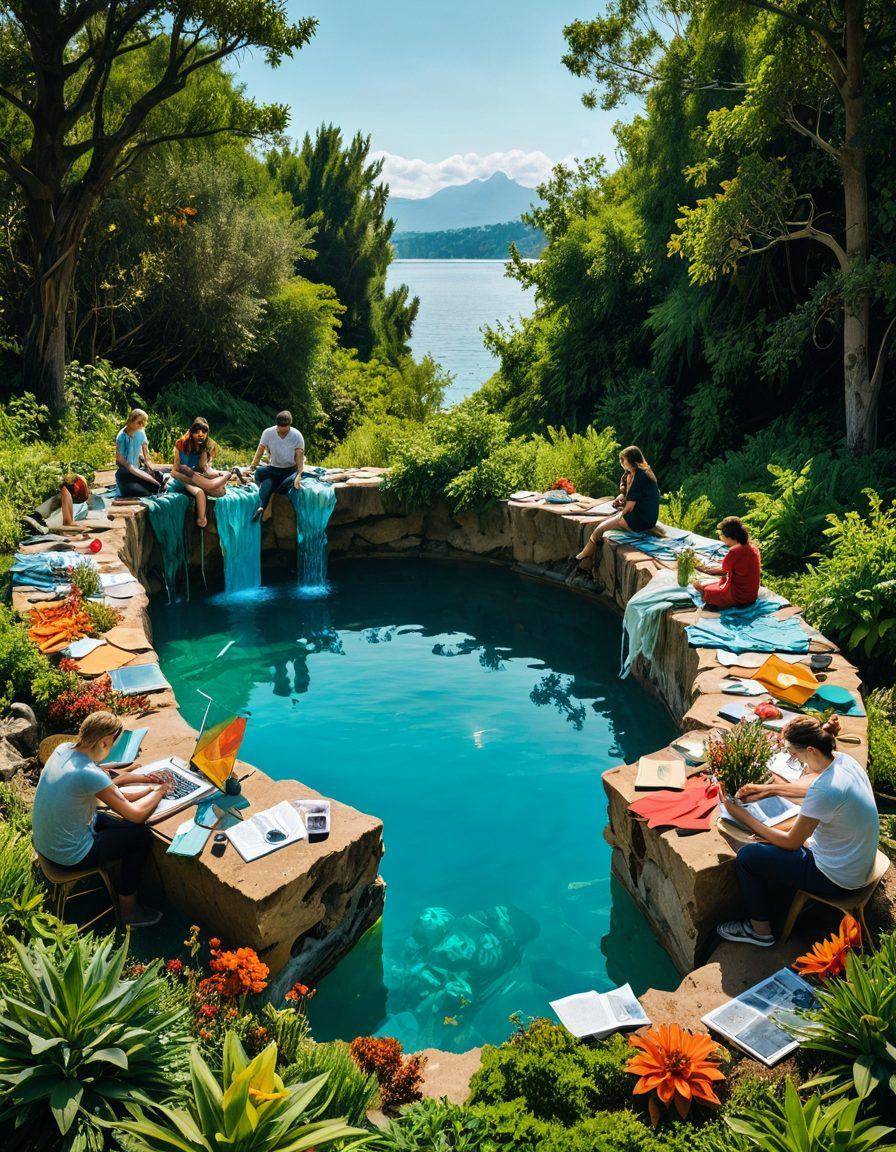Artivism for the Planet: How Contemporary Artists Are Tackling the Climate Crisis with Eco-Friendly Expressions
In an age where everyday conversations revolve around the climate crisis, a vibrant movement is emerging from the minds and hearts of contemporary artists. These creative forces are not just passive observers of environmental challenges; they are actively participating in a revolution of art activism. They wield their brushes, cameras, and other forms of artistic expression for sustainability, shedding light on pressing environmental issues while employing eco-friendly techniques. This is not merely an artistic endeavor; it is an impassioned call to action, aimed at fostering environmental awareness and urging society to rethink its relationship with nature.
The landscape of contemporary environmental art is captivating. Artists are taking inspiration from nature, transforming their artworks into powerful channels of advocacy for climate justice. Imagine walking through a gallery where every piece of art challenges the viewer to consider their carbon footprint reduction or highlights the urgent need for nature conservation. The pieces are crafted from recycled materials, echoing themes of sustainability and reinforcing the message that our planet’s health is a shared responsibility. Each brushstroke becomes a voice within the green art movement, reminding us of the very essence of art as a form of social commentary.
Take a moment and ponder: What if our world was a canvas and our actions were the pigments that shape its future? Artists everywhere are answering that call, and the results are nothing short of breathtaking. From immersive installations that give viewers a sensory understanding of the climate crisis to outdoor sculptures that blossom into thriving ecosystems, these artistic expressions breathe life into the idea of environmentally conscious design. Their work invites audiences to interact, reflect, and engage with the basic tenets of environmentalism. It's no wonder that the artivism scene is rapidly gaining traction!
Consider the story of a contemporary artist who turns plastic waste into striking nature art. By crafting intricate designs from materials that would otherwise contribute to pollution, he not only transforms discarded objects into something beautiful, but he also pushes a powerful message about the importance of reducing our waste. His work encapsulates the heart of art activism — it demonstrates how eco art can inspire future generations to advocate passionately for planetary health and adopt greener initiatives. Isn't it invigorating to think how creative minds are spearheading conversations around sustainability?
As society grapples with the realities of the climate crisis, the role of socially conscious art becomes ever more significant. Artists are at the forefront of this movement, serving as both catalysts and guides, directing us towards a more sustainable future. They invite us to experience their art not just as a display, but as a manifesto for change. Each piece is a question posed to the audience: What will you do for our planet? Through their lenses, we are challenged to rethink our priorities and become active participants in nurturing and protecting the environment. In this rich tapestry of artistic expression for sustainability, we find hope, urgency, and inspiration; a reminder that while the challenges are great, so too are the creative solutions.
From Canvas to Conservation: The Role of Art in Promoting Environmental Awareness
Art has always been a powerful medium for expression, but in the age of the climate crisis, artists are transforming their canvas into a clarion call for environmental awareness. From vivid paintings depicting the majestic beauty of nature to thought-provoking installations made from recycled materials, contemporary artists are stepping into the realm of artivism. They stand at the forefront of the green art movement, wielding their brushes not just to create beauty but to ignite change and inspire action. As artist Brian Andreas once said, "Art is the most beautiful way to hold something up to the light." In a world beset by the consequences of climate change, how do these artists hold our planet up to the light?
At the heart of this artistic activism lies the intersection of art and ecology. As climate advocates, many artists are shifting their focus to projects that promote nature conservation and sustainability. They encapsulate themes such as the fragility of planetary health and the impact of human activity on the environment. For instance, works that utilize sustainable design principles and recycled art showcase the incredible potential of materials that would otherwise end up in landfills. Each piece becomes a narrative, urging viewers to reflect on their carbon footprint and the importance of reducing waste. Is there a way we can take inspiration from these artists and apply their lessons to our daily lives?
Storytelling through art in service of climate justice also sparks a sense of community and shared responsibility. When artists utilize their talents to highlight critical social issues, audiences become more engaged. This socially conscious art often inspires collaboration among local green initiatives, weaving together community members through workshops and interactive installations. Imagine an engaging mural in your neighborhood that reflects the beauty of nature and encourages collective action against pollution. What conversations could this art ignite? How might it motivate local citizens to actively participate in environmentalism?
The role of nature art in advocating for the preservation of our planet is more crucial than ever. Many artists are harnessing their skills to create immersive experiences that transport viewers into the heart of nature, connecting them directly with the very essence of the environments that are at risk. Consider an installation made entirely of biodegradable materials, transforming an ordinary space into a vibrant ecosystem. The juxtaposition of contemporary environmental art and the urgent need for action can evoke profound emotions, pushing individuals to question their own role in the unfolding climate crisis. But, how can we channel this emotion into meaningful action?
As we traverse the landscape of artistic expression for sustainability, it becomes clear that art serves as a vital tool in amplifying the efforts of the green art movement. By leveraging art activism, artists are fostering conversations that encourage awareness and inspire change. They remind us that we are not mere spectators, but active participants in the fight against the climate crisis. So, what can you do to join this movement? Engage with local art projects, support artists who focus on eco art, and incorporate sustainable practices into your daily routine. Together, through art and community, we can cultivate a culture rooted in environmental awareness, nurturing a healthier planet for generations to come.
Eco-Friendly Art Movements: Merging Artistic Expression with the Fight for Planetary Health
Artivism is the intersection of art and activism, and it’s gaining momentum in the face of today's climate crisis. Contemporary artists are stepping up with bold and innovative expressions that not only highlight the urgency of environmental awareness but also inspire action. What if art could be the spark that lights our path towards a greener future? As we explore eco-friendly art movements, we’ll discover how these artists are merging artistic expression with the fight for planetary health. From recycled art projects to sustainable design initiatives, the possibilities are both inspiring and transformative.
Think of the vibrant pieces of nature art that tell a story beyond their colors and shapes. These artworks are not mere decorations; they serve as powerful reminders of our relationship with the environment. By using materials that reduce carbon footprints, such as reclaimed wood, discarded plastics, and even living plants, artists are manifesting green initiatives in their work. Remember the quote by artist Christo, who once said, "The land is a canvas.” This sentiment speaks volumes about the connection between art and ecology, urging us to rethink how we engage with the world around us. What if we could transform our perceptions of waste into something beautiful and meaningful?
Have you ever wondered how art activism can challenge societal norms and provoke conversations about climate justice and environmentalism? Eco artists are doing just that. By using artistic expression for sustainability, they invite us to confront uncomfortable truths about our lifestyles and the impact they have on the planet. Through exhibitions and installations that captivate and educate, these creators stir up emotions that move us beyond apathy into action. This green art movement not only amplifies the message of climate advocacy but also creates a community of like-minded individuals who champion nature conservation and the preservation of our planet.
Among the fascinating developments within contemporary environmental art, one movement stands out: recycled art. Artists transform waste materials into breathtaking pieces that challenge the viewer’s perception of beauty and worth. Each sculpture or installation is a resounding call to action, urging us to rethink our consumption habits. Can art be a vehicle for change that inspires us to minimize our carbon footprints? The answer lies in the motivation behind these artworks—the desire to connect and the commitment to promote a sustainable future. With the rise of socially conscious art, we not only see a shift in how we create but also in how we perceive our role as caretakers of the Earth.
In essence, eco-friendly art movements resonate with a universal truth: we possess the power to impact the world around us. Artists who practice artivism remind us that creativity can be a catalyst for change, illuminating paths toward a better future. By merging artistic expression with passion for the planet, they inspire individuals and communities to engage in environmental work actively. So, what role will you play in this movement? Will you support these artists, adopt sustainable practices, or perhaps even contribute your own creations to the fight for planetary health? The journey of balancing art and ecology is just beginning, and every step counts in this vital advocacy for our shared home.


